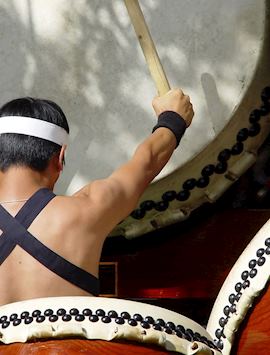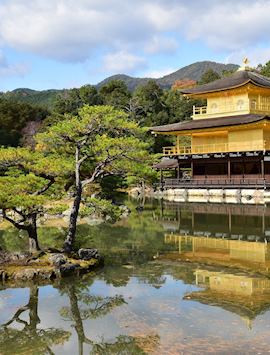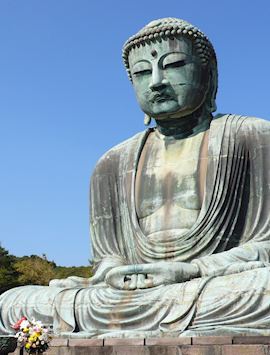By Audley Japan specialist James
A safe, clean and exciting country, Japan has all the credentials for a great family holiday. There’s plenty to keep children of all ages entertained from futuristic museums, hypnotic game centres and walking robots, to ninja restaurants, snow monkeys and calligraphy courses.
The fast and efficient bullet train is an attraction in itself, but it also provides an easy way to travel around the country with your family, while there’s a wealth of restaurants and accommodation that cater for all tastes.
Explore futuristic Tokyo

For all its neon and skyscrapers, Tokyo effortlessly combines modern and innovative attractions with age-old traditions and cultural experiences. You could spend the morning in a tranquil temple, and in the afternoon visit the most advanced humanoid robot in the world, ASIMO, in the Honda Welcome Plaza.
The city is also home to Studio Ghibli, an animation film studio responsible for the likes of the anime film Spirited Away, and Tokyo Disneyland. Visit the museum to find out where the films were originally created and even watch a short animated feature, before venturing up to the rooftop garden, where a five metre (16 foot) high robot stands guard.
See the snow monkeys in Yudanaka

The spa town of Yudanaka in the Japanese Alps, about three hours by train from Tokyo, is known for its natural hot springs and its snow monkeys.
These sociable creatures spend most of their time in and around their own hot spring, where you can watch them in their hundreds popping in and out of the water and quarrelling over stones. Though they remain in the region throughout the summer, the monkeys are particularly amusing to observe in winter, when the snow piles up on their heads as they keep warm in their thermal bath.
I’d recommend spending one night in Yudanaka to give you and your family time to relax in the healing waters after visiting the snow monkeys.
Travel on the bullet train

This magnificent feat of engineering reaches speeds that are unheard of anywhere else in the world. The bullet train, or the Shinkansen to the Japanese, is a thrilling and futuristic way to travel around Japan.
More than 99 percent of bullet trains run within one minute of expected arrival time. Few other places in the world would consider a 30-minute delay on the trains a TV newsworthy event. The Shinkansen comprise only a small fraction of the total Japan Rail network.
Private cars and drivers can be prohibitively expensive in Japan, and the coverage and reliability of the network allows you to criss-cross the country in comfort and at the minimum of expense.
I’d recommend copying the Japanese and picking up a bento box at the train station to eat on board. These meal boxes consist of four or five compartments which include rice, a side salad and grilled or breaded meat. Children’s varieties also include a picture of Hello Kitty or equivalent.
Combine cultural experiences with the great outdoors in Kyoto

Kyoto contains some of the nation’s greatest cultural treasures including a concentration of historic buildings. These pavilions, temples and palaces are scattered across the city, so I suggest that the easiest way to explore them for yourself is by public transport.
In-between visiting some of the city’s key sites, there’s a range of hands-on activities you could sample to keep everyone entertained. Set aside an hour or two and you could find yourself making paper cranes, participating in a tea ceremony or fulfilling a long-held dream of becoming a samurai warrior.
When you do come to explore Kyoto’s temples and shrines it can be hard to choose which ones to visit. My top pick is the Golden Pavilion, set in a landscaped stroll garden, which places high importance on a path, usually around a pond, that allows you to saunter around.
The gold leaf that adorns the building is what gives the temple its name. Upon leaving the complex look out for an ice cream shop that sells ice cream wrapped in edible gold leaf.
As part of your visit to any of the temples, children (and adults) are very welcome to take part in traditional formalities such ringing bells, burning incense and giving a donation before bowing and clapping twice.
I’d recommend combining culture and tradition with a few outdoor activities. Kyoto is brimming with green spaces that are perfect for family picnics, walking and letting off steam. Also, just a short train ride away you can ride the rapids of the Hozu River and go rock jumping as part of a two-hour watery adventure.
Try a traditional pastime

Japan’s long-held leisure pursuits offer an intriguing insight into local culture, and there are a number of family-friendly activities you can include in your Japan holiday. Geisha culture — the art of entertaining with conversation, dance, music and drink pouring — is still prevalent in Kyoto and you can spend some time in the Gion district of the city, even trying on the traditional kimono similar to those worn by these elusive Geisha ladies.
Other activities include classes in kembu where you’ll get a feel for how to use a samurai sword and traditional taiko drumming where you’ll get to learn about the long history of the instrument, which was also used to motivate troops in battle, and have a go yourself.
Alternatively, if you’d like to try something a little more sedate with your family, you can try Japanese calligraphy or origami with the WAK (Women’s Association of Kyoto) in a traditional family home.
Try a range of Japanese dishes

Contrary to popular belief, Japanese cuisine is more than just raw fish. Meat dishes are popular and are some of the best I’ve tried anywhere, a particular favourite being wagyu beef.
There’s also tempura (vegetables or fish cooked in a light batter), okonomiyaki, a pancake dish that’s often cooked in front of you and can include cabbage, pork, egg and sometimes noodles, topped with sweet okonomiyaki sauce and aonori (seaweed flakes), and various rice or noodle dishes to name but a few.
Dining options are varied and include typically Japanese dishes as well as international alternatives. In Kyoto and Tokyo ‘all you can eat’ restaurants provide a cost-effective choice. And for a quirkier dining experience try one of Tokyo’s many themed restaurants which offer a relaxed and interactive experience. For example, you’ll be guided through an underground labyrinth before being served and entertained by ninjas at Ninja Akasaka.
Where to stay with your family in Japan

A stay in traditional ryokan accommodation (Japanese inn) is a much bigger experience than somewhere to rest for the night. The customs and etiquette that come with staying in a ryokan are unlike anything you’ll experience in Western culture.
You’ll find yourself sleeping on a large, comfy futon on tatami (rice straw and soft rush) or bamboo matting, being served your evening meal in your room or a dining room by a kimono-clad maid, and eating around a short table as you sit cross-legged on the floor.
Some ryokans also have private hot spring baths, known as onsens. The popular Japanese pastime of bathing in thermal waters would normally take place in a communal spa, with men and women bathing separately.
Each ryokan has its own individual characteristics, and range from simple, authentic stays to more modern properties with luxurious facilities. Your specialist can help you pick one that best suits your family.
In Tokyo, the Gracery is a great choice for families. Situated in Shinjuku district, the hotel features a model of Godzilla on the roof and offers interconnecting rooms.
For something even more unusual, spend a few nights in temple lodgings at Mount Koya, where you’ll be given the opportunity to take part in sunrise chanting with the monks. The town itself is a UNESCO World Heritage Site, and in the evening you can stroll along the winding, lantern-lit paths of Okuno-in Cemetery, which locals believe is haunted.
The best time to visit Japan with your family

The peak times to visit Japan are during cherry blossom season between late March and mid April, and red leaf season between late October and November. I would recommend avoiding a trip to Japan with your family at these times of the year, instead visit in May or at Christmas. To watch the snow monkeys as snowflakes settle on their heads is a real delight in winter between December and January and you can also ski in Japan at this time.
Start planning your family trip to Japan
Start thinking about your experience. These itineraries are simply suggestions for how you could enjoy some of the same experiences as our specialists. They're just for inspiration, because your trip will be created around your particular tastes.
View All Tours in Japan




